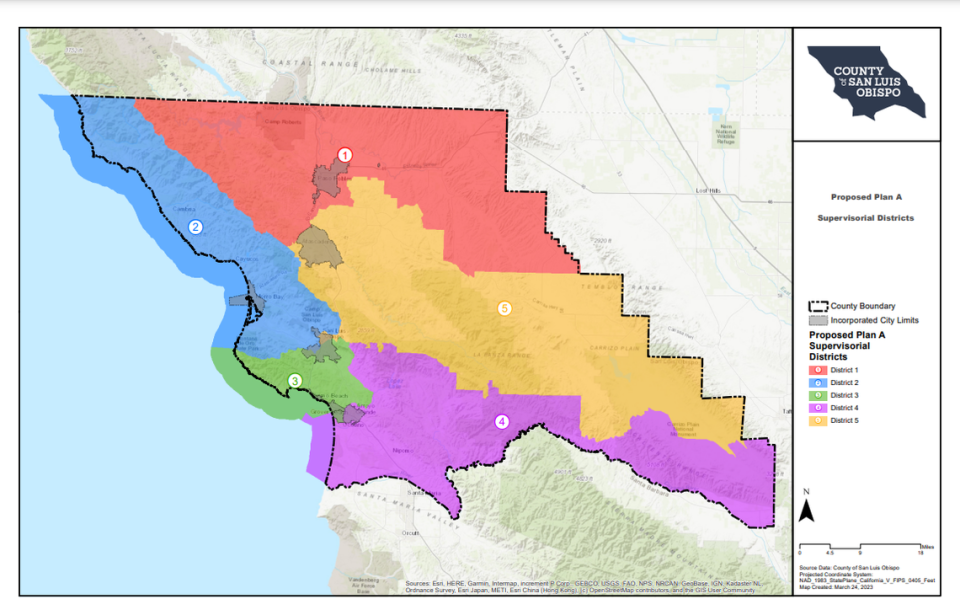An independent redistricting commission for SLO County? Yes please! | Opinion
Of all the actions San Luis Obispo County’s new, liberal-leaning Board of Supervisors have taken this year, no decision is as significant as this: By a 3-2 vote, supervisors have agreed to begin the process of creating an independent redistricting commission.
This much-needed reform will help safeguard the rights of generations of SLO County voters by stripping politicians of the ability to manipulate district lines to their advantage, as was so grossly displayed by the Republican board majority in 2021. The practice is such a blatant conflict of interest — and so rife for abuse — that it’s shocking it’s been allowed to go on as long as it has.
Details of San Luis Obispo County’s proposed independent redistricting commission have yet to be worked out — the board plans to gather input from the community before drafting a final plan.
Supervisors aim to put the issue on the November 2024 ballot. Given the outcry that followed SLO County’s last round of redistricting — together with the fact that Democrats now have a sizable lead in voter registration — passage appears likely.
Map looked like ‘a plate of spaghetti’
While redistricting is often contentious, what happened in 2021 was next-level despicable.
While feigning wide-eyed innocence and good intentions, the former Republican majority radically redrew boundaries that had been in place for decades, refusing all attempts to compromise.
A few districts — especially District 2 in the North Coast — were torn apart and reassembled in a way that gave Republicans an edge in three of the five districts, even though Democrats outnumber Republicans countywide. A group of concerned citizens banded together and filed a lawsuit.
Supervisor Dawn Ortiz-Legg recalled her initial reaction to the map during the board’s Sept. 12 discussion on the independent redistricting commission, or IRC.
“I called it a plate of spaghetti, is what it looked like to me,” she said. “I never saw a map anything like it.”
Democrats still managed to win three seats in 2022 under the “plate of spaghetti” map — a point that Supervisor John Peschong raised in arguing against the need for a redistricting commission.
“You all talk about how this map was so bad. This map created districts that were swing districts ... and you have three people up here who won their seats,” he said.
But it could easily have gone the other way. Supervisor Bruce Gibson, whose “old” district had been heavily Democratic, won election by just 13 votes in a redrawn district where Republicans were suddenly in the majority.
Supervisor Debbie Arnold joined Peschong in voting against a redistricting commission.
“I just think that things run smoother when the busy voting citizens have less complication instead of more complication,” she said.
Busy citizens are not going to be forced into serving on the commission — just as no one is forced to serve on a planning commission or parks and recreation board. They will have to apply for the job.
Another thing: If the process ran smoothly as Arnold believes it does, citizens would not find it necessary to file a lawsuit against the county practically every time a new map is drawn up.
State may require large counties to appoint commissions
San Luis Obispo County isn’t the only jurisdiction where redistricting has been source of controversy — another clue that the current system isn’t working out so well.
The California Department of Justice is currently investigating whether the Butte County Board of Supervisors violated state voting rights law when it redrew district boundaries after the 2020 census.
Last year, three California counties — Kern, Fresno and Riverside — were required to form redistricting commissions because the maps they had drawn diluted the power of Latino votes.
Some counties — Santa Barbara is one — have voluntarily switched to a redistricting commission.
Others could soon join.
AB-1248, a bill that would require all counties with populations above 300,000 to appoint a redistricting commission, has passed both houses of the state Legislature and is awaiting a decision from the governor. (San Luis Obispo County’s population is just under 280,000, so it would not be affected.)
It’s unfortunate that the Legislature did not include smaller counties in the bill, since they are just as vulnerable to gerrymandering as larger ones.
Counties do have the option to act on their own, however, by drafting an ordinance creating a commission, as SLO County is doing.
Can politicians be impartial?
Independent redistricting commissions don’t guarantee a perfect process, though there are safeguards that minimize conflicts of interests.
Not allowing politicians to appoint the commissioners is one. Limiting the political involvement of appointees is another. For instance, under AB-1248, anyone who contributed $500 or more to a board member in a single year is ineligible.
For the statewide commission, qualified applicants are placed in sub-pools of Democrats, Republicans and third party or no party preference voters, and applicants are selected from each category.
Random drawings have been used to choose some members, though that can lead to a lack of diversity.
That is exactly what occurred in the random drawing for the statewide redistricting commission in 2020. Out of the first eight names randomly pulled, not one was Latino.
“This shouldn’t have happened,” the Los Angeles Times wrote in an editorial. “Not in a state in which Latinos are the largest ethnic group, accounting for about 40% of the nearly 40 million residents.” (Four Latinos were later chosen to serve.)
There’s no question that choosing a commission will be a challenging process for San Luis Obispo County, but it will be major improvement over the current system when it comes to restoring voter trust.
It will also give supervisors a break from the political drama that occurs every 10 years.
No matter what map they choose, supervisors are bound to upset a good chunk of the electorate.
A speaker at the Sept. 12 meeting put it this way: “One decision that you should not be required to make is how to draw these districts. It is not reasonable to ask elected officials to impartially decide their own boundaries.”
It’s time we relieve them of this duty, for their sake and ours.



